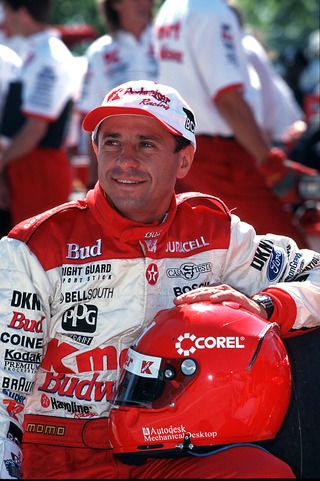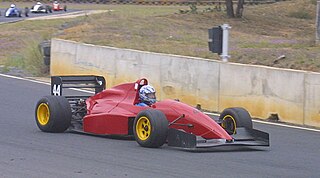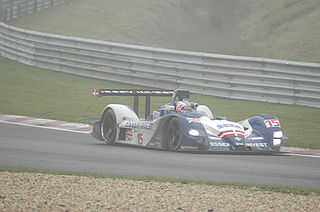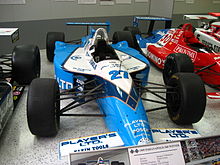
The Formula 3000 International Championship was a motor racing series created by the Fédération Internationale de l'Automobile (FIA) in 1985 to become the final preparatory step for drivers hoping to enter Formula One. Formula Two had become too expensive, and was dominated by works-run cars with factory engines; the hope was that Formula 3000 would offer quicker, cheaper, more open racing. The series began as an open specification, then tyres were standardized from 1986 onwards, followed by engines and chassis in 1996. The series ran annually until 2004, and was replaced in 2005 by the GP2 Series.
Lola Cars International Ltd. was a British race car engineering company in operation from 1958 to 2012. The company was founded by Eric Broadley in Bromley, England, before moving to new premises in Slough, Buckinghamshire and finally Huntingdon, Cambridgeshire, and endured for more than fifty years to become one of the oldest and largest manufacturers of racing cars in the world. Lola Cars started by building small front-engined sports cars, and branched out into Formula Junior cars before diversifying into a wider range of sporting vehicles.

Maurício Gugelmin is a Brazilian former racing driver. He took part in both Formula One and Championship Auto Racing Teams (CART). He participated in 80 Formula One Grands Prix, debuting in 1988 for the March team. Gugelmin achieved one top-three finish and scored a total of ten championship points in the series. He competed in CART between 1993 and 2001, starting 147 races. Gugelmin won one race, in 1997 in Vancouver, finishing fourth in the championship that year. His best result in the Indianapolis 500 was in 1995 where he started and finished in sixth position, leading 59 laps. For a period, he held the world speed record for a closed race track, set at California Speedway in 1997 at a speed of 240.942 mph (387.759 km/h). Gugelmin retired at the end of 2001 after a year that included the death of his third child.

Roberto Pupo Moreno, usually known as Roberto Moreno and also as Pupo Moreno, is a Brazilian former racing driver. He participated in 75 Formula One Grands Prix, achieved 1 podium, and scored a total of 15 championship points. He raced in CART in 1986, and was Formula 3000 champion before joining Formula One full-time in 1989. He returned to CART in 1996 where he enjoyed an Indian summer in 2000 and 2001, and managed to extend his career in the series until 2008. He also raced in endurance events and GT's in Brazil, but now works as a driver coach and consultant, and although this takes up a lot of his time, he is not officially retired yet, as he appears in historic events. Away from the sport, he enjoys building light aeroplanes.
Pacific Racing was a motor racing team from the United Kingdom. Following success in lower formulae, the team took part in two full seasons of Formula One, in 1994 and 1995, entering 33 Grands Prix without any success.
March Engineering was a Formula One constructor and manufacturer of customer racing cars from the United Kingdom. Although only moderately successful in Grand Prix competition, March racing cars enjoyed much better success in other categories of competition, including Formula Two, Formula Three, IndyCar and IMSA GTP sportscar racing.

Formula racing is any of several forms of open-wheeled single-seater motorsport. The origin of the term lies in the nomenclature that was adopted by the FIA for all of its post-World War II single-seater regulations, or formulae. The best known of these formulae are Formula One, Formula E, Formula Two, Formula Three, regional Formula Three and Formula Four. Common usage of "formula racing" encompasses other single-seater series, including the IndyCar Series and the Super Formula Championship.
Adrian John Reynard is a businessman and commercial astronaut. He is the founder of Reynard Motorsport, which was a successful racing car manufacturer before it went bankrupt in 2002.

Formula Holden was an Australian open wheel racing category introduced in 1989.
The Barber Dodge Pro Series was a professional open-wheel auto racing series from 1986 to 2003. It was one of the first professional spec series for open-wheel racecars in North America. The races were primarily on road and street courses in North America, although the schedule did sometimes include a few ovals.
Malcolm Oastler is an Australian. He was the former technical director of Formula One team BAR, former chief engineer for Jaguar Racing, and designer of many race cars.

Judd is a brand of racing car engines built by Engine Developments Ltd., a company founded in 1971 by John Judd and Jack Brabham in Rugby, Warwickshire, England. Engine Developments was intended to build engines for Brabham's racing efforts, and became one of the first firms authorised by Cosworth to maintain and rebuild its DFV engines, but has since expanded into various areas of motorsport.

Ralt was a manufacturer of single-seater racing cars, founded by ex-Jack Brabham associate Ron Tauranac after he sold out his interest in Brabham to Bernie Ecclestone. Ron and his brother had built some specials in Australia in the 1950s under the Ralt name. Tauranac won the 1954 NSW Hillclimb Championship in the Ralt 500.
The 1991 Formula 3000 International Championship was the seventh season of Formula 3000 in Europe. Christian Fittipaldi won the championship after ten rounds.
Gary Anderson is a British semi-retired racing car designer and motorsport pundit/commentator.

The Reynard 02S was a Le Mans Prototype race car built by Reynard Motorsport in 2002. Intended to replace the failed Reynard 2KQ prototype, the 02S would end up becoming the final new design from Reynard as the company went bankrupt prior to the project's completion.
The British Formula 3000 championship, alternatively known as the British Formula Two Championship, was a competition for Formula 3000 held in the United Kingdom, active from 1989 to 1994 and in 1996. Several attempts to restart the series since then have met with failure.
KW Motorsport Ltd have a wide range of engineering consultancy in Champ car and Le Mans series including the design of the Nasamax, Protan and Creation AutoSportif chassis that are based on Reynard Motorsports original products. The Company is based alongside its sister company KW Special Projects Ltd at Reynard Park, Brackley, England, where it is currently working on the adaptation and regeneration of MARCH Engineering’s iconic Le Mans prototype, the MARCH 75S.
Andrew Thorby is a British racecar designer. Thorby designed many formula racing and Le Mans Prototype cars.
Diane Holl is a British engineer who has worked in Formula One, Championship Auto Racing Teams (CART), and NASCAR. She is employed at the Hendrick Motorsports NASCAR team as director of vehicle engineering.













